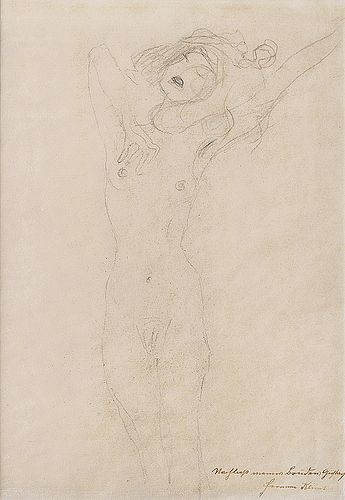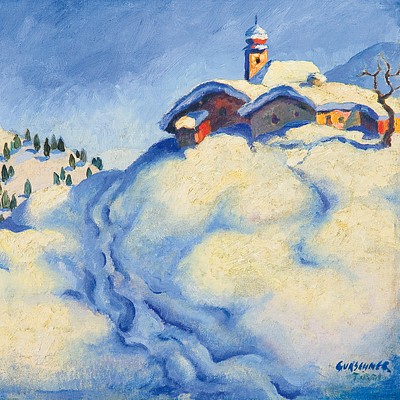GUSTAV KLIMT (Baumgarten near Vienna 1862 - 1918 Vienna)
Lot 39
Estimate:
EUR€15,000 - EUR€30,000
$15,625 - $31,250
Absentee vs Live bid
Two ways to bid:
- Leave a max absentee bid and the platform will bid on your behalf up to your maximum bid during the live auction.
- Bid live during the auction and your bids will be submitted real-time to the auctioneer.
Bid Increments
| Price | Bid Increment |
|---|---|
| EUR€0 | EUR€10 |
| EUR€100 | EUR€50 |
| EUR€700 | EUR€100 |
| EUR€1,000 | EUR€200 |
| EUR€3,000 | EUR€300 |
| EUR€3,600 | EUR€400 |
| EUR€4,000 | EUR€500 |
| EUR€7,000 | EUR€1,000 |
| EUR€16,000 | EUR€2,000 |
| EUR€30,000 | EUR€3,000 |
| EUR€36,000 | EUR€4,000 |
| EUR€40,000 | EUR€5,000 |
| EUR€150,000 | EUR€10,000 |
About Auction
By Widder Auctions
Nov 23, 2023
Set Reminder
2023-11-23 11:00:00
2023-11-23 11:00:00
America/New_York
Bidsquare
Bidsquare : Masterpieces
https://www.bidsquare.com/auctions/widder-auctions/masterpieces-14076
Masterpieces by Austrian and German artists are coming up for auction in Vienna on November 23rd Widder Auctions office@widderauktionen.com
Masterpieces by Austrian and German artists are coming up for auction in Vienna on November 23rd Widder Auctions office@widderauktionen.com
- Lot Description
GUSTAV KLIMT (Baumgarten near Vienna 1862 - 1918 Vienna)
sketch for Beethoven frieze, ca. 1901
pencil/paper, 45,2 x 32 cm
inscribed Nachlass meines Bruders Gustav, Hermine Klimt (estate of my brother Gustav, Hermine Klimt)
we thank Dr. Bisanz-Prakken, who has inspected the art work and confirmed the inclusion in the catalogue raisonné of Gustav Klimt
ESTIMATE € 15000 - 30000
STARTING PRICE € 15000
The Austrian painter Gustav Klimt was the most famous representative of Viennese Art Nouveau and founding president of the Vienna Secession. His brothers Ernst Klimt the Elder J. and Georg Klimt were also artists. He studied from 1876 to 1883 at the Vienna School of Applied Arts under Ferdinand Laufberger, Victor Berger, Ludwig Minnigerode, Karl Hrachowina and Michael Rieser. In the 1880s, together with his brother Ernst (registered with Lehmann: Gebrüder Klimt) and Franz Matsch, he formed a studio community run as an artist company. In 1891, Klimt became a member of the Vienna Visual Artists' Cooperative ( Künstlerhaus ). In 1897 he left the Künstlerhaus and was one of the founders of the Vienna Secession, of which he was its first president from 1897 to 1899. He designed the metal doors for the Secession building built by Josef Olbrich in 1897/1898. In 1898 the Secession held its first exhibition; Klimt provided images and illustrations for “Ver Sacrum”. In 1894, Klimt and Matsch were commissioned to decorate the ceiling of the newly built university with paintings. The proposal was rejected and there was a break between the two artists. Karl Kraus, who did not appreciate Klimt's style, defended the rejection of the philosophy painting in "Die Fackel”. In 1902, Klimt created the Beethoven Frieze for the 14th Secession exhibition (with Klinger's Beethoven statue). In 1903 the Secession showed 80 of Klimt's works. In 1905, Klimt and a group of artists, including Carl Moll, left the Secession because some fellow painters, including Josef Engelhart, pursued a style that was too “naturalistic” for him. Klimt's pictures were removed from the Secession. Klimt had a close friendship with Josef Hoffmann and Koloman Moser, the founders of the Wiener Werkstätte. In 1904 Hoffmann was entrusted with designing a city palace for Adolphe Stoclet in Brussels. Klimt was commissioned by Fritz Wärndorfer, Wiener Werkstätte, to design the frieze (so-called Stoclet frieze) for the dining room of the palace. In 1905, Klimt exhibited in the 2nd annual exhibition of the German Artists' Association and received the Villa Romana Prize. In 1906, Klimt became an honorary member of the Royal Bavarian Academy of Fine Arts in Munich. Klimt's “The Kiss” was created in 1907–1908. The picture was shown at the Vienna Art Show in 1908 and was commissioned by the k. k. Ministry of Culture and Education purchased. In 1912 he became president of the Association of Austrian Artists. He exhibited in Prague and Dresden in 1908, in Munich in 1909, and at the IX in 1910. Venice Biennale. In 1911 he exhibited in Rome; In 1912 again in Dresden, in 1913 in Budapest, Munich and Mannheim. In 1916 he could be seen with Schiele and Kokoschka in the federal exhibition in Berlin. From 1900 to 1916, Gustav Klimt spent most of his summer holidays on Lake Attersee in Upper Austria, especially in the villa of the court carpenter Friedrich Paulick. The majority of his landscape paintings were created here. Klimt maintained close relationships with his clients, who came primarily from the assimilated Jewish upper bourgeoisie in Vienna. He was close friends with Serena Lederer, the wife of August Lederer, with Adele Bloch-Bauer, the wife of the sugar industrialist Ferdinand Bloch-Bauer, and with Alma Mahler-Werfel. Emilie Flöge, for whose fashion salon Klimt made designs for reform dresses, is described as his partner. A Klimt monument designed by Anton Hanak in 1927/8 was not realized.
PLEASE NOTE:
The purchase price consists of the highest bid plus the buyer's premium, sales tax and, if applicable, the fee of artists resale rights. In the case of normal taxation (marked °), a premium of 24% is added to the highest bid. The mandatory sales tax of 13%, for photographys 20%, is added to the sum of the highest bid and the buyer's premium. The buyer's premium amounts to 28% in case of differential taxation. The sales tax is included in the differential taxation.
- Shipping Info
-
Shipping Terms
We will send you the invoice shortly after the auction. As soon as we have recieved the amount, the art can be picked up at Johannesgasse 9-13, 1010 Vienna. Please note that the buyer is responsible for pick-up and shipping of the lot.
Should you wish to ship your items, please contact:
Mailboxes
Email: oper@mbe-co.at
Tel: 01 5128855
Please note that storage fees may apply, should the pieces not be picked up within 14 days after invoicing for domestic and 28 days for international transportation.
Our team will be happy to assist you with any further information at office@widderauktionen.com or at 0043 676 555 66 10.
-
- Buyer's Premium



 EUR
EUR CAD
CAD AUD
AUD GBP
GBP MXN
MXN HKD
HKD CNY
CNY MYR
MYR SEK
SEK SGD
SGD CHF
CHF THB
THB













